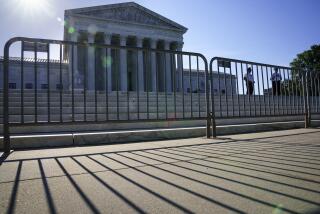A courtside view of the highest judicial activists in the land
- Share via
A Court Divided
The Rehnquist Court and the Future of Constitutional Law
Mark Tushnet
W.W. Norton: 384 pp., $27.95
*
“Writing about the Supreme Court is like shooting at a moving target,” warns Mark Tushnet in a lucid new book on the nation’s highest tribunal. Rare indeed is any title that hits as many bull’s eyes as does “A Court Divided,” a volume that is consistently perceptive and perfectly timed. With Chief Justice William H. Rehnquist suffering from thyroid cancer and expected to leave soon, the court is poised for change.
Much news media chatter about the U.S. Supreme Court offers hyperbole and caricatures; Tushnet provides dependable characterizations of the Rehnquist court’s rulings and its justices. Though he is an iconoclastically liberal Georgetown University law professor who clerked for Justice Thurgood Marshall in 1973 when Roe vs. Wade was decided, Tushnet toes no party line in his commentary and gives frank evaluations of many of the justices. “A Court Divided” is thus an informative and refreshing read even when addressing important but obscure constitutional issues.
Two major themes undergird his analysis. First, everyone on today’s court “is a judicial activist,” including conservative Justices Antonin Scalia and Clarence Thomas and swing-vote Justices Anthony M. Kennedy and Sandra Day O’Connor. But the Rehnquist court has been “a conservative activist court on issues the public basically doesn’t care much about -- federalism and property rights -- and was a moderately liberal activist court on the social issues that attract public attention -- abortion and gay rights.” As a result, the Rehnquist court’s “commitment to a strong vision of judicial supremacy” has drawn criticism from the left as well as the right.
The court’s best-known rulings, such as its 1992 reaffirmation of Roe vs. Wade in Planned Parenthood vs. Casey and its landmark declaration of gay equality in 2003 in Lawrence vs. Texas, continue to outrage social conservatives. But Tushnet writes that its efforts to “revolutionize federalism doctrine” have rarely drawn widespread interest, for “no one besides the justices really cares about federalism.” Academic commentators have complained vociferously about the court’s effort to magnify its power at the expense of Congress, but as Tushnet accurately observes, that essentially has had no effect “on the actual exercise of congressional power.”
Second, Tushnet contends that divisions between cultural conservatives and economic conservatives are central to understanding the Rehnquist court. This imprecisely highlights how different Scalia and Thomas are from not only O’Connor and Kennedy but also Justices John Paul Stevens and David H. Souter, two Republican appointees who often vote with Clinton appointees Justices Ruth Bader Ginsburg and Stephen G. Breyer. Scalia and Thomas have dissented from all of the court’s abortion and gay rights rulings, but in the federalism and property rights arenas, O’Connor and Kennedy have cast the decisively conservative votes in case after case.
Tushnet’s comments on individual justices will surprise some readers. He calls “the rigorously originalist” Thomas, who advocates a return to pre-20th century understandings of the Constitution, “the Court’s true revolutionary” whose judicial opinions are “certainly more interesting and distinctive than what Scalia has done” and have “a greater chance of making an enduring contribution to constitutional law.”
Scalia, Tushnet notes, has repeatedly been guilty of “a failure of good judgment” in using “venomous” language to publicly criticize his colleagues, especially O’Connor.
At the other end of the ideological spectrum, Tushnet describes Ginsburg as “somewhat remote and opaque” and “not generally a warm and open person.” Breyer comes across as “a somewhat eccentric academic” who asks lawyers “complex and long-winded questions” that can be “so convoluted that it’s often hard to see their point.”
He characterizes O’Connor as “somewhat formal and remote” and Kennedy as having a “growing sense of his own public importance,” but whose “pomposity” is “mostly harmless.” Only Stevens and Souter, for whom Tushnet’s daughter Rebecca has worked as a law clerk, emerge unscathed.
Far less hinges on who is nominated and confirmed to replace Rehnquist than interest groups on both the right and the left would have you believe. As with federalism, issues that do intensely divide the current justices, such as “the Court’s increasing interest in constitutional developments” beyond U.S. shores, have much greater academic appeal than real-world import. In contrast, the most controversial subjects, gay rights and abortion, are the ones on which the court likely will do as little as possible.
This outstanding book may startle and surprise, but there is no better way to learn about today’s Supreme Court.
*
David J. Garrow is the author of “Liberty and Sexuality: The Right to Privacy and the Making of Roe v. Wade.”
More to Read
Get the L.A. Times Politics newsletter
Deeply reported insights into legislation, politics and policy from Sacramento, Washington and beyond. In your inbox twice per week.
You may occasionally receive promotional content from the Los Angeles Times.










